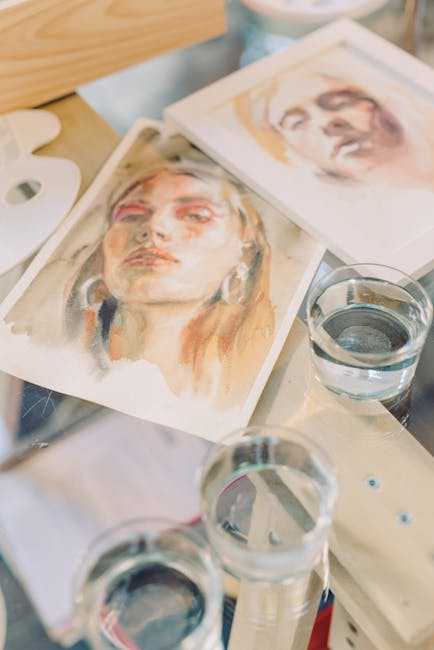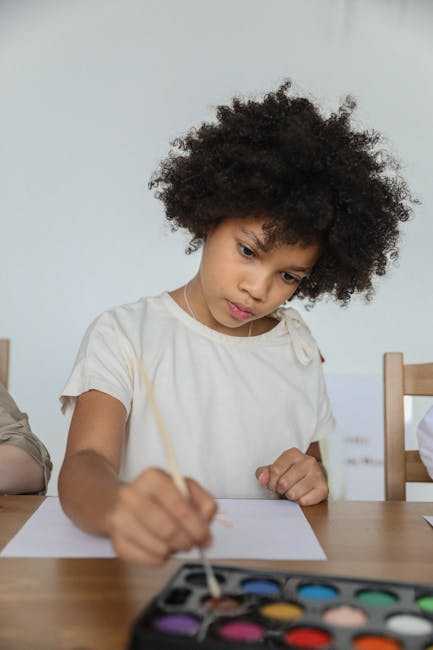Table of Contents
- Exploring the Intricacies of Watercolor Techniques
- Essential Tools for Every Watercolor Artist
- Color Theory in Watercolors: A Comprehensive Guide
- Tips for Creating Stunning Watercolor Landscapes
- Q&A
- insights and Conclusions


Exploring the Intricacies of Watercolor Techniques
Watercolor painting is a captivating art form that thrives on the delicate balance between control and spontaneity. With its translucent layers and vibrant hues, artists can explore a spectrum of effects, each technique offering its unique charm. From glazing to wet-on-wet, understanding these approaches can elevate your artistry and open new avenues of creative expression.
Glazing is one of the fundamental techniques in watercolors that involves layering transparent washes over dried paint. This method allows for the creation of depth and luminosity in the artwork.Each layer interacts with the ones beneath it, producing complex colors that can evolve dramatically. To master glazing,its essential to allow adequate drying time between layers to avoid muddiness.
On the other hand, the wet-on-wet technique invites unpredictability. By applying wet paint onto a wet surface, artists can achieve a soft diffusion of colors, which creates beautiful, organic shapes akin to those found in nature. This method is notably effective in landscapes where soft edges and atmospheric effects are desired. It beckons the artist to embrace spontaneity and adapt to the paints’ natural flow.
| Technique | Characteristics | Ideal Uses |
|---|---|---|
| Glazing | Layering of transparent colors | Portraits, floral compositions |
| Wet-on-Wet | soft blending and diffusion | Landscapes, abstract art |
Moreover, the dry brush technique provides another exciting avenue for adding texture and detail. By using a brush with minimal moisture, artists can create fine lines and rich textures that stand out against the softer washes. This method is perfect for creating realistic fur,hair,or rough surfaces,making it an invaluable tool for many artists.
Essential Tools for Every Watercolor Artist
Every watercolor artist knows that having the right tools can make all the difference in achieving stunning effects and smooth techniques. The foremost item in any artist’s toolkit is, of course, watercolor paints. These come in various forms, including tubes, pans, and liquid. Tubes offer rich color saturation, while pans are often favored for their portability and ease of use. Watercolor paints are typically made from pigments and binders, and artists should choose high-quality brands to ensure vibrant, lasting results. Some notable brands include Winsor & Newton,Daniel Smith,and Schmincke.
Another indispensable item is watercolor paper. The texture and weight of the paper significantly impact the final artwork. Artists should opt for 100% cotton paper, which provides a luxurious feel and excellent water absorption. The primary types of watercolor paper include hot-pressed (smooth), cold-pressed (not rough), and rough, each serving different styles and techniques. A recommended weight for effective watercoloring is at least 200 gsm to prevent warping.
Alongside paints and paper, having a selection of high-quality brushes is critical for mastering various techniques. Watercolor brushes are typically made from natural or synthetic fibers, with round and flat brushes being the most common shapes. A versatile starter kit might include:
- Round Brushes: For detailed work and fine lines.
- Flat Brushes: For washes and strokes covering larger areas.
- Mop Brushes: Ideal for wet-on-wet techniques and large washes.
Lastly, proper accessories can elevate a watercolor artist’s experience. Consider using a water container with a secure lid for easy cleaning on the go, a palette for mixing colors, and masking fluid to preserve areas of white paper. These tools enhance workflow and creativity, allowing artists to focus more on their expression rather than logistical challenges. Remember, investing in quality tools provides not just utility but also elevates the painting experience, providing artists with the freedom to explore their creative potential.


Color Theory in Watercolors: A Comprehensive Guide
Understanding color theory is essential for any watercolor artist aiming to create striking and harmonious artwork. Watercolors possess a unique luminosity that stems from their openness, making color choices even more critical. Familiarity with the color wheel not only helps in selecting compatible hues but also in exploring color relationships such as complementary, analogous, and triadic schemes. By mastering these concepts, artists can evoke emotions, create depth, and convey stunning visual narratives through their work.
Primary colors – red, blue, and yellow – serve as the foundation. These hues cannot be created by mixing other colors and are the basis for all other colors in the spectrum. When mixed equally, primary colors create secondary colors, which include green, orange, and purple. Further mixing of primary and secondary colors leads to the creation of tertiary colors, enhancing the palette available for artists. This harmonious system of color allows for endless combinations and variations, vital in watercolor painting.
To effectively apply color theory, it’s critically important to consider temperature and value. Colors can be categorized as warm (reds, oranges, yellows) or cool (blues, greens, purples), influencing the mood of a piece. As an example, warm colors tend to evoke excitement while cool colors can impart calmness. Additionally, understanding value-the lightness or darkness of a color-enables artists to achieve contrast and focus within their artwork. By balancing these elements, one can direct the viewer’s attention and create visual harmony.
Another crucial aspect of color theory in watercolors is the use of color mixing techniques. Artists can experiment with wet-on-wet, wet-on-dry, and dry brush techniques to manipulate how colors interact on the paper. Here’s a simple overview of mixing techniques:
| Technique | description |
|---|---|
| Wet-on-wet | Applying wet paint onto wet paper for soft, blended edges. |
| Wet-on-Dry | Applying wet paint onto dry paper for sharp, defined shapes. |
| Dry Brush | Using a minimal amount of paint on a dry brush for texture and detail. |
By utilizing these color theory principles and techniques in watercolors, artists can expand their creative possibilities and enhance the impact of their artwork.Engaging with color thoughtfully not only leads to aesthetically pleasing results but also nurtures a deeper understanding of visual dynamics,allowing for a more expressive artistic journey.


Tips for Creating Stunning Watercolor Landscapes
Creating breathtaking watercolor landscapes involves blending technique with creativity. Begin by selecting a color palette that reflects the mood of your scene. Watercolors thrive on subtlety, so choose colors that harmonize rather than clash.Consider using analogous colors-those next to each other on the color wheel-for smooth transitions, or experiment with complementary colors to create striking contrasts. Remember to limit your palette to avoid overwhelming your work; three to five colors are often sufficient to convey depth and interest.
When it comes to composition, think about the rule of thirds. This approach encourages you to divide your canvas into nine equal parts, placing focal points along these lines or at their intersections. This technique can dramatically enhance the visual interest in your landscape. additionally,don’t hesitate to incorporate elements like foreground,midground,and background to create depth. By layering these elements, you can draw the viewer’s eye through the scene, enhancing its overall impact.
Watercolor painting requires a balance between control and fluidity. Always start with a light wash to establish your shapes before building up layers of color. This technique allows for greater flexibility as you progress. Utilize wet-on-wet techniques for soft blends and stunning skies, while wet-on-dry can keep your edges crisp for detailed elements like trees or buildings. Here’s a speedy comparison of techniques:
| Technique | Description |
|---|---|
| Wet-on-Wet | Applies wet paint onto a wet surface for soft blending effects. |
| Wet-on-Dry | Applies wet paint onto a dry surface for precise lines and details. |
| Layering | Building colors in layers to enhance depth and richness. |
Lastly, embrace the unpredictability of watercolor. Sometimes, the most striking effects come from happy accidents-those unexpected blooms or drips that add character to your piece. Allow yourself to step back occasionally and assess your work from a distance, which can reveal opportunities for adjustment or enhancement that you might miss up close. Trusting the medium and your instincts will lead to stunning outcomes you can be proud of.
Q&A
Q&A: Exploring the World of Watercolor Art
Q1: What are watercolors, and how do they differ from other painting mediums?
A1: Watercolors are a transparent painting medium that uses pigment suspended in a water-based solution. Unlike oils or acrylics, which offer more opacity and blending opportunities, watercolors tend to create softer, more fluid effects. The transparency of watercolors allows for layering, enabling artists to build depth and luminosity in their works.
Q2: What types of watercolor paints are available?
A2: there are two main types of watercolor paints: pan and tube. Pan watercolors come in solid form and are activated with water,making them ideal for travel. Tube watercolors are in a viscous state and are favored for their vibrant colors and ease of mixing.The choice between them often depends on the artist’s style and preference.
Q3: What are the essential supplies needed for watercolor painting?
A3: To get started with watercolor painting, you’ll need a few key supplies:
- Watercolor paints (either pan or tube)
- Brushes (various sizes and shapes)
- watercolor paper (designed to handle moisture without warping)
- A palette for mixing colors
- A container for water
- Paper towels for blotting or drying
Q4: How do I choose the right watercolor paper?
A4: Selecting the right watercolor paper depends on the techniques you’ll use. There are three primary types: rough, cold-pressed (NOT), and hot-pressed (smooth). Rough paper is excellent for textured effects, cold-pressed has a slight texture suitable for most techniques, and hot-pressed is great for fine detail work. The weight of the paper is also crucial; heavier papers (300 lb) are more absorbent and resist warping better than lighter ones.
Q5: Is it difficult to learn watercolor painting, and what are some tips for beginners?
A5: while watercolor painting can be challenging due to its unpredictability, it’s definitely an accessible medium for beginners. Here are a few tips:
- Start with basic techniques like wet-on-wet and wet-on-dry to understand how water and pigment interact.
- Practice patience; watercolors can dry lighter than expected, so layer gradually.
- Experiment with different brush strokes and color mixing to find your unique style.
Q6: What are some common watercolor techniques to explore?
A6: There are numerous techniques to explore in watercolor, including:
- Wet-on-Wet: Applying wet paint onto wet paper for soft blends.
- Wet-on-Dry: Applying wet paint onto dry paper for more defined edges.
- Glazing: Layering transparent washes over dried paint to create depth.
- Salt Texture: Sprinkling salt onto wet paint to create captivating textures.
Q7: Can watercolors be used for different styles of art, or are they limited to certain genres?
A7: Watercolors are incredibly versatile! They can be used for various styles, including landscapes, portraits, abstract pieces, and more. many artists appreciate watercolors for their ability to evoke emotion and atmosphere, making them suitable for both realistic and whimsical interpretations.
Q8: How can I improve my watercolor skills over time?
A8: Continuous practice is key to improving your watercolor skills. Here are some strategies to help you grow:
- Take classes or watch online tutorials for guided practice.
- Join workshops or local art groups to connect with fellow artists.
- Maintain a sketchbook where you can experiment freely and document your progress.
- Analyze works by other artists and try to replicate techniques to expand your skill set.
This Q&A addresses common questions and provides valuable insights to help both beginners and experienced artists navigate the enriching world of watercolor painting.
